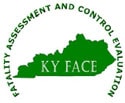Solid Waste Driver Dies After Single Vehicle Rollover
Kentucky Case Report: 08KY074
Report Release Date: August 28, 2009
Summary
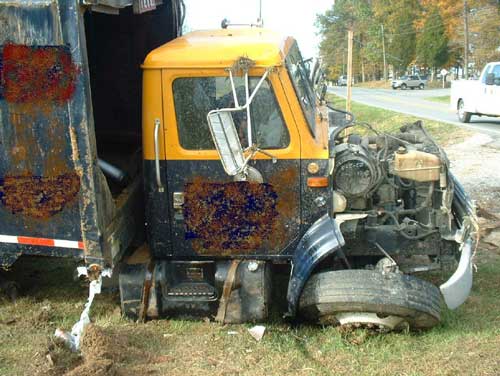 |
|---|
|
Photograph of solid waste truck involved in motor vehicle crash. |
On the morning of a fall day in 2008, a 59 year-old male solid waste worker (Driver 1) entered the cab of a company solid waste truck parked in his driveway and drove to a restaurant a few miles away. After leaving the restaurant, the driver was observed weaving by another solid waste driver (Driver 2) at least two times in the northbound lane of a two-lane state highway. After he had driven 1.8 miles in a little over 2 minutes away from the restaurant, the driver entered a right-hand curve in the highway. While in the curve, the driver crossed the centerline and drove into the southbound lane, then crossed the northbound lane and off the right side of the highway. The driver hit a culvert, rolled the vehicle, and the driver was ejected from the driver’s door. The truck came to rest on its right side in the front yard of a private residence.
Driver 2 called emergency services to the scene, parked his solid waste truck off the highway and exited the cab. He ran to where Driver 1 was lying on the ground; found Driver 1 conscious and instructed Driver 1 not to move. Emergency services arrived, transported Driver 1 via ambulance and helicopter to the nearest Level 1 trauma hospital. While enroute, Driver 1 died. According to Driver 2, Driver 1 did not attempt to brake while the incident was occurring. Skid marks on the highway in the curve were from a previous incident involving a semi tractor-trailer.
To prevent future occurrences of similar incidents, the following recommendations have been made:
- Recommendation No. 1: Commercial vehicle carriers should implement and enforce a workplace policy that requires drivers to wear seat belts while operating a commercial vehicle.
- Recommendation No. 2: Companies with remote drivers should implement a supervisory system to oversee drivers on a daily basis.
- Recommendation No. 3: Companies with commercial drivers should perform random verification of driver motor vehicle records.
Background
The decedent involved in this incident worked as a regular, full-time, swing driver for a waste management company which was acquired by another waste management company approximately two years prior to the incident. It is unknown how many years the decedent had worked in the waste management industry prior to the acquisition.
The company had been in business since 1997 and had several locations that provided waste management services for residential, commercial, construction, and industrial customers. There were 16 drivers located at the office from which the decedent worked. Typically, drivers drove the same solid waste truck and drove dedicated routes. Solid waste trucks were parked in the lot by the office when not in use. There were four types of trucks used by the company: 1) roll-off; 2) front-load, used for commercial customers; 3) side load; 4) rear load. Sometimes two workers were scheduled for the rear load trucks. The other truck types usually only required one worker, the driver, to perform the route. Usually, a driver would pick up a solid waste truck from the company lot, collect solid waste, drive to the local transfer station, empty the load, return the truck to the company lot, and go home. Drivers that drove remote routes, 25 miles away from the company lot, kept their trucks at home. Remote drivers began their route from their home, performed the route, drove to the nearest transfer station, emptied the truck, then returned home. Swing drivers substituted for regular drivers and were regular employees. Tippers (workers who accompanied drivers on unfamiliar routes and who assist in solid waste collection and navigation) accompanied regular drivers and swing drivers when necessary. Commercial route drivers could begin their routes as early as midnight and residential route drivers could begin as early as 6:00 AM. A typical workweek was approximately 45 hours long.
The company had a comprehensive safety program with a dedicated safety manager reinforcing the program daily. Included in the safety program were weekly and monthly safety talks. A driver observation program was in place. Once a month, a random driver was observed by the safety manager as they performed their routes. Drug and alcohol testing was performed as required by the Kentucky Department of Transportation. All fleet trucks were equipped with surveillance video cameras in the cab.
The temperature the day of the incident was 38° Fahrenheit, with a humidity of 47%. The winds were from the west at 6 mph, and the sunrise was at 7:05 AM.
Investigation
In the fall of 2008, the Kentucky Fatality Assessment Control and Evaluation program was notified of an occupational fatality involving a driver of a solid waste truck. An evaluation of the incident was initiated the following spring. Two company representatives, the responding police officer and reconstructionist, were interviewed. FACE personnel made a site visit and took photographs where the incident occurred.
At approximately 7:00 AM, a swing driver (Driver 1) for a solid waste management company left his house, and entered the cab of a rear-load solid waste truck parked in his driveway. Manufactured in 1998, the truck had a gross vehicle weight rating of 25,500 pounds. The driver’s duties were to collect solid waste along a residential rural route that was approximately 30 miles from the company office. He was a swing driver filling in for the regular driver who was on vacation. Driver 1 lived in the area, was familiar with the route, and did not have a tipper to assist him.
When he left his driveway, Driver 1 proceeded to a nearby restaurant where he ordered two sausage and egg sandwiches to go. Upon leaving the restaurant, Driver 1 had a conversation with another solid waste driver (Driver 2) from another solid waste management company. At approximately 7:15 AM both drivers entered the cabs of their respective solid waste trucks and began their routes. Driver 1 was in front of Driver 2 as they drove out of the parking lot. Driver 1 turned left onto a two lane state highway in a northerly direction with Driver 2 following behind.
As they drove north, Driver 2 observed Driver 1 weave, and cross the center line at least two times. They had driven a little over 2 minutes and had traveled 1.8 miles from the restaurant when they were in a right-hand curve of the highway and Driver 1 crossed the center line and drove into the southbound lane. Driver 1 then drove across the northbound lane, off the right side of the highway, and with the right front of the truck, struck a 9 ft 8 in x 1 ft 1 in concrete culvert located 5 ft. 3 inches from the edge of the pavement. The tie rod broke, the right front tire broke off, and the truck frame was scraped by the culvert. The truck rolled end-over-end for approximately 90 feet into the front yard of a private residence. As the truck rolled, the back right tire struck the ground and the driver was ejected out the driver’s door. Driver 1 landed on the ground and the truck continued to roll another 30 feet over a 16 ft. wide gravel driveway where it came to rest on its right side next to the driveway, and 12 feet from the highway, having rolled a total distance of 137 feet from the culvert (Diagram 1).
Driver 2 called emergency services to the scene, parked his solid waste truck off the highway and exited the cab. He ran to where Driver 1 was lying on the ground and found Driver 1 face-down and conscious. Driver 2 instructed Driver 1 not to move. Emergency services, complete with air ambulance, arrived at the scene. The air ambulance landed in the yard of the residence near where Driver 1 lay on the ground. Driver 1was loaded into the air ambulance and was transported to the nearest Level 1 trauma hospital. While in route, Driver 1 died and the helicopter was diverted to the nearest hospital where the coroner declared Driver 1 dead on arrival.
According to Driver 2, Driver 1 did not attempt to brake while the incident was occurring. Skid marks on the pavement in the curve were from a previous incident involving a semi tractor-trailer. Driver 1 tested positive for a blood alcohol level of 0.18% at the time of the incident.
A reconstructionist examined the collision scene. After examining the vehicle and its maintenance records, the reconstructionist determined there were no mechanical or physical problems with the vehicle to cause the crash. The investigation also revealed Driver 1’s driver license was valid, but his commercial driver’s license had been suspended for unknown reasons. According to the Federal Motor Carrier Safety Administration standard 49 CFR Part 383.51(b) Suspension of Driver 1’s CDL could have been for a variety of reasons such as following too closely (60-day suspension) or committing a felony while operating a commercial vehicle (life-long suspension).
Back to Top
Cause of Death
The death certificate states the cause of the driver’s death was due to multiple injuries as a consequence of a motor vehicle collision.
Recommendations/Discussion
Recommendation No. 1: Commercial vehicle carriers should implement and enforce a workplace policy that requires drivers to wear seat belts while operating a commercial vehicle.
Kentucky and Federal laws both require commercial drivers to wear seat belts when operating a commercial vehicle. Kentucky Revised Statute 189.125(6) requires drivers and all passengers to be restrained by properly adjusted and fastened seatbelts. 49 Code of Federal Regulations §392.16-Use of seat belts, states that a commercial vehicle is equipped with a seatbelt, and the driver must properly restrain himself/herself with the seatbelt. To help employers develop and institute a seatbelt training program, the Federal Motor Carrier Safety Administration developed the “Commercial Vehicle Safety Belt Program”. A manual, “Increasing Safety Belt Use in Your Company”, is available to help companies develop a seatbelt usage program and is available at http://www.fmcsa.dot.gov/safety/safety-belt/increasing-safety-belt-use-your-company-manual. (Link Updated 4/8/2015)
Recommendation No. 2: Companies with remote drivers should implement a supervisory system to oversee drivers on a daily basis.
Companies with remote drivers need a supervisory system to help ensure that company drivers who leave from their residence on company business are competent to operate a motor vehicle. One system that is used by businesses to stay in contact with remote employees is through live computer video programs, such as Skype, which are inexpensive to implement and easy to use. A live video system allows the employer to have a “face-to-face” meeting anytime with an employee. Both can be in front of a laptop or desktop computer equipped with a camera and an appropriate video software program. Before beginning a route, the driver can contact the company office visually with the computer and check in. This gives management an opportunity to give last minute instructions to employees, and to have visual contact with the driver before work commences. Management with visual contact abilities via the computer may be able to identify impaired drivers before they begin their routes. In this instance, the driver had a blood alcohol level of .18% when he began driving, but management did not have visual contact with the driver to assess if he was impaired.
Recommendation No. 3: Companies with commercial drivers should perform random verification of driver motor vehicle records.
According to 49 Code of Federal Regulations §383.33 Notification of Drivers License Suspension, CDL drivers who are notified that their CDL has been suspended, revoked, or cancelled has the responsibility to inform their employer by the end of the next business day after receiving the notification. Companies with commercial drivers are required by 49 Code of Federal Regulations §391.25 Annual Inquiry and Review of Driving Record to verify driver motor vehicle records annually. To ensure that company drivers are in compliance with the law, a semiannual random check of each driver’s motor vehicle records status should be performed by the company.
Keywords:
Blood alcohol level
Solid waste truck
Seatbelt
References
- 49 Code of Federal Regulations Part §383.51(b) Disqualification of drivers
- Kentucky Revised Statute Part §189.125(6)
- 49 Code of Federal Regulations Part §392.16-Use of seat belts
- Federal Motor Carrier Safety Administration, “Increasing Safety Belt Use in Your Company”, http://www.fmcsa.dot.gov/safety/safety-belt/increasing-safety-belt-use-your-company-manual. (Link Updated 4/8/2015)
- 49 Code of Federal Regulations Part §383.33 Notification of Drivers License Suspension
- 49 Code of Federal Regulations Part §391.25 Annual Inquiry and Review of Driving Record
Acknowledgements
Company representatives
Federal Motor Carrier Safety Administration
Local police officer/ reconstructionist
Solid waste industry representative
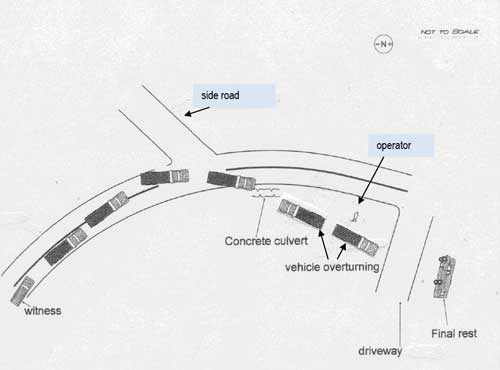 |
|
Diagram 1: Schematic of incident. Courtesy of law enforcement. |
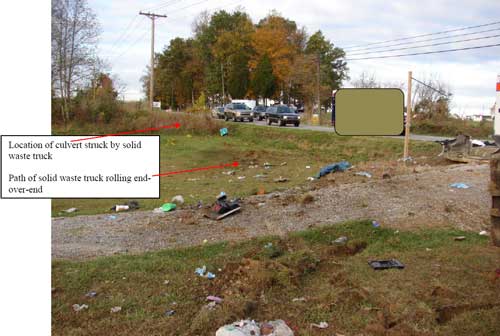 |
|
Photograph of path of solid waste truck after leaving the highway and striking a culvert. Photograph courtesy of law enforcement. |
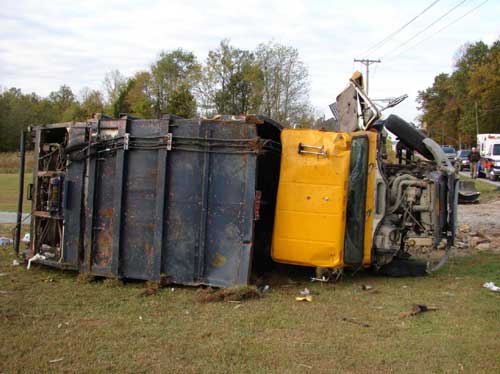 |
|
Photograph of solid waste truck where and how it came to rest after rolling end-over-end. Photograph courtesy of law enforcement. |
Kentucky FACE Program
The Kentucky Fatality Assessment & Control Evaluation Program (FACE) is funded by a grant from the Centers for Disease Control and the National Institute of Safety and Health. The purpose of FACE is to aid in the research and prevention of occupational fatalities by evaluating events leading to, during, and after a work related fatality. Recommendations are made to help employers and employees to have a safer work environment. For more information about FACE and KIPRC, please visit our website at: www.mc.uky.edu/kiprc/ (Link updated 3/27/2013)
To contact Kentucky State FACE program personnel regarding State-based FACE reports, please use information listed on the Contact Sheet on the NIOSH FACE web site. Please contact In-house FACE program personnel regarding In-house FACE reports and to gain assistance when State-FACE program personnel cannot be reached.

